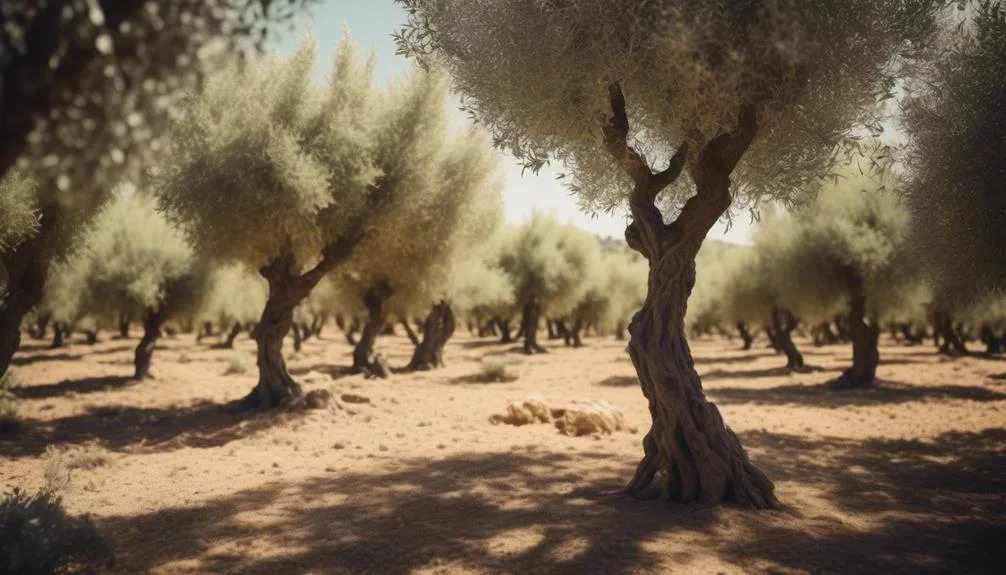Ancient olive trees do more than just produce olives and oil. They also play a crucial role in supporting biodiversity by influencing wildlife habitats, soil health, and pollinator diversity.
Exploring the connection between olive trees and biodiversity reveals how these majestic trees contribute to the intricate web of life.
Key Takeaways
- Olive trees provide habitats for diverse plant and animal species, supporting a rich and varied understory of insects, birds, and small mammals.
- They contribute to soil health by enriching the soil with organic matter and nutrients, reducing erosion, and promoting the growth of beneficial soil microorganisms.
- Olive trees attract a diverse array of pollinators with their delicate blossoms and rich nectar, ensuring the reproduction of the olive tree and other plant species.
- Promoting biodiversity through olive farming involves implementing sustainable agricultural practices, integrating olive trees with other crops, avoiding monoculture, and enhancing soil fertility, thus creating a thriving ecosystem and conserving biodiversity.
Role of Olive Trees in Biodiversity
Olive trees play a crucial role in supporting biodiversity by providing habitats for a diverse array of plant and animal species. Their broad, evergreen canopies offer shade and protection for a variety of smaller plants, creating a rich and varied understory. This environment supports a wide range of insects, birds, and small mammals, contributing to the overall health of the ecosystem.
The presence of olive trees also helps to prevent soil erosion, promoting the stability of the surrounding landscape. Furthermore, their deep root systems help to improve soil structure and fertility, benefiting neighboring plant species.
Impact of Olive Trees on Wildlife Habitats
The rich and varied understory created by the broad, evergreen canopies of olive trees supports a wide range of insects, birds, and small mammals, contributing significantly to the overall health of the ecosystem and creating vital wildlife habitats.
The presence of olive trees plays a crucial role in wildlife conservation and habitat preservation. The dense foliage provides nesting sites for birds, while the insects and small mammals find shelter and food among the branches and fallen leaves.
This diverse ecosystem supports a healthy food chain, benefiting larger predators and contributing to the overall balance of the environment.
Additionally, olive trees contribute to the preservation of natural habitats, ensuring that a variety of species can thrive within the ecosystem.
This interconnected web of life underscores the importance of olive trees in supporting wildlife habitats and promoting biodiversity.
Olive Trees and Soil Health
Nurturing the soil and fostering its health, olive trees play a vital role in maintaining the ecological balance of their surroundings. Here's how olive trees contribute to soil health:
- Soil Fertility: The fallen leaves of the olive tree decompose, enriching the soil with organic matter and nutrients. This enhances the fertility of the soil, promoting the growth of diverse plant species.
- Erosion Prevention: Olive tree roots help bind the soil, reducing erosion caused by wind and water. This helps in maintaining soil structure and preventing nutrient loss.
- Microbial Activity: The roots of olive trees exude compounds that promote the growth of beneficial soil microorganisms, contributing to overall soil health.
- Ecosystem Resilience: By improving soil fertility and structure, olive trees contribute to the resilience of the entire ecosystem, supporting the survival of various flora and fauna.
Olive Trees and Pollinator Diversity
With their delicate blossoms and rich nectar, olive trees attract a diverse array of pollinators, playing a crucial role in supporting the biodiversity of their ecosystems.
The intricate flowers of the olive tree provide a vital food source for a range of pollinators, including bees, butterflies, and other insects. These pollinators, drawn by the sweet fragrance and abundant nectar, engage in complex behaviors such as foraging and pollination, contributing to the ecological balance of the olive tree's habitat.
As they move from bloom to bloom, pollinators facilitate the reproduction of the olive tree and various other plant species, ensuring the continuation of diverse flora.
Promoting Biodiversity Through Olive Farming
Promote biodiversity through olive farming by implementing sustainable agricultural practices that support the coexistence of diverse plant and animal species.
Agroforestry benefits from integrating olive trees with other crops, creating a more varied and balanced ecosystem.
Ecological balance is achieved by avoiding monoculture and instead cultivating a mix of native plant species alongside olive trees.
This approach enhances soil fertility and reduces the need for chemical inputs, fostering a healthier environment for various wildlife.
By preserving natural habitats and utilizing organic farming methods, olive farming contributes to the conservation of biodiversity.
This results in a thriving ecosystem where an array of flora and fauna can flourish, ultimately benefiting both the environment and the agricultural landscape.
Conclusion
Olive trees are vital for biodiversity, providing habitats for wildlife, fostering soil health, and supporting pollinator diversity. Their presence in agricultural landscapes is essential for preserving natural ecosystems and overall environmental well-being.
Understanding the significance of olive trees in promoting biodiversity is crucial for sustainable farming practices that benefit the land and its diverse species.
How can we continue to prioritize and support the role of olive trees in maintaining biodiversity for the future?

